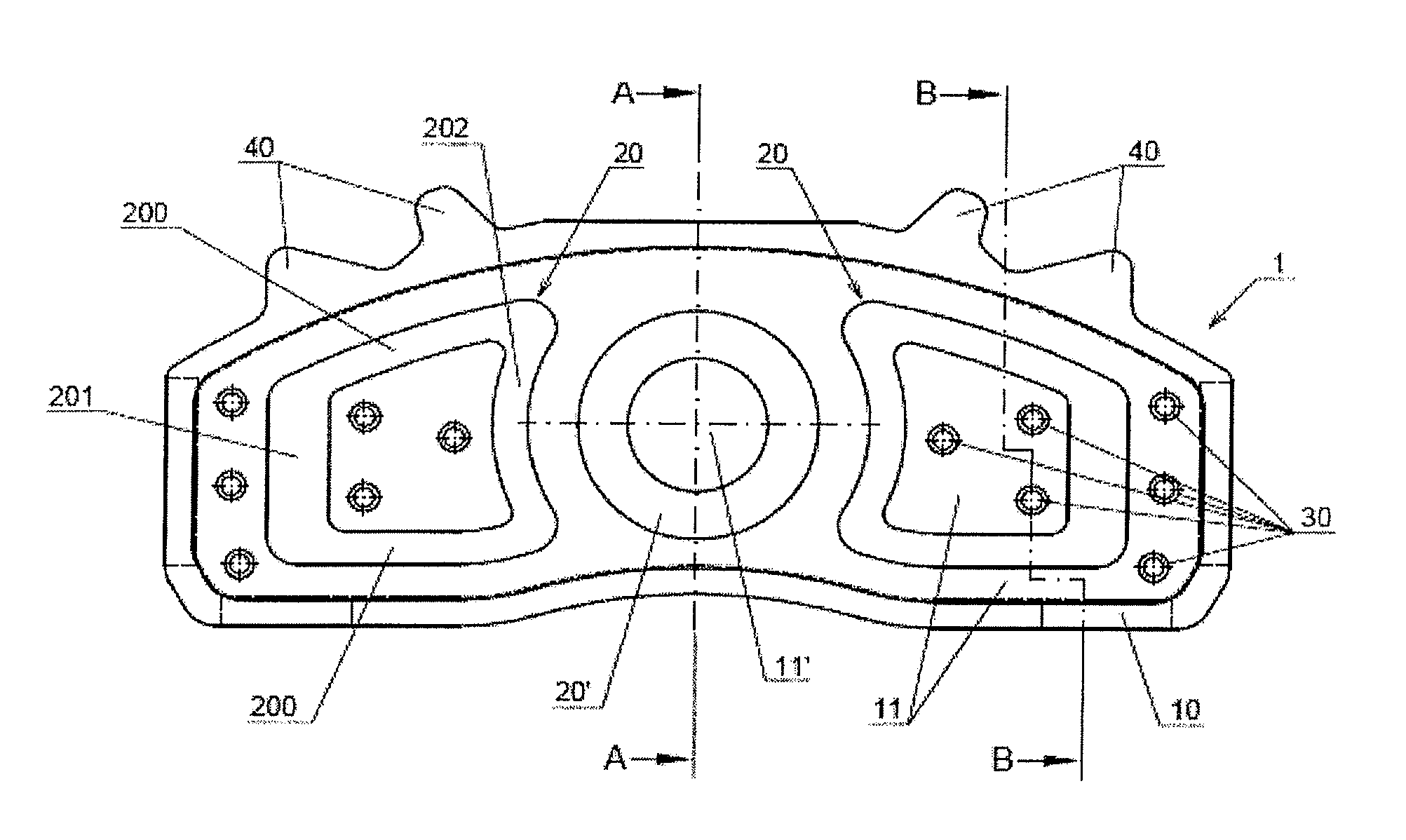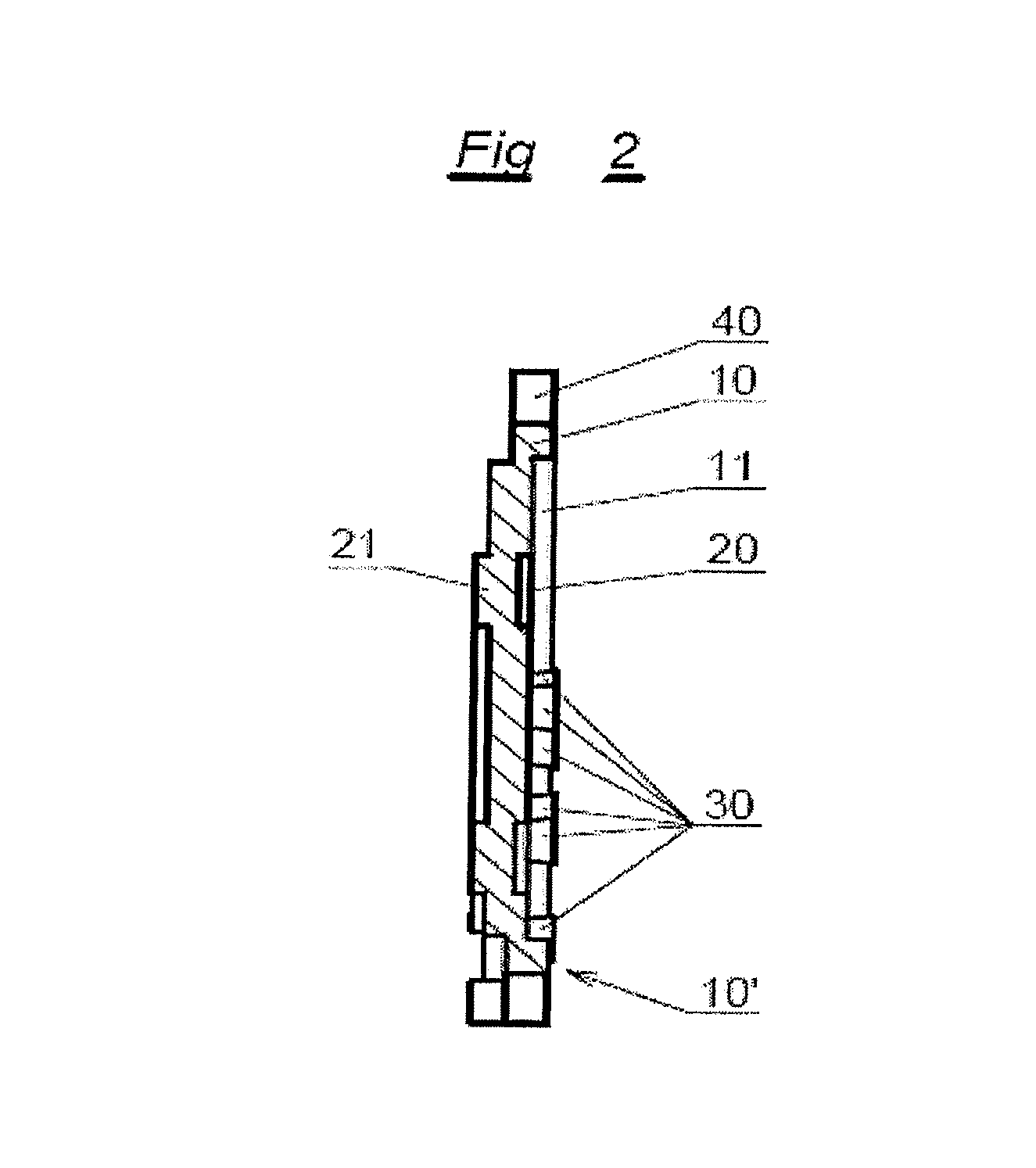[0013]Another advantage of the invention lies in the fact that the use of at least two depressions of different depths can reduce the amount of friction lining used in comparison to a friction lining carrier plate that only has one single depression, provided that the thickness of the two friction lining carrier plates is the same. The reason for this is that the first and second depressions have different depths. The depth of the first depression is less than that of the second depression or vice versa. As a result, less friction lining material is needed since, due to the smaller depth of the first depression, less friction lining material is needed in order to fill the first and second depressions than would be the case if a friction lining carrier plate were provided with only one depression having a constant depth. As a result, friction material on the front of the friction lining carrier plate is displaced by the depressions created by shaping on the rear of the friction lining carrier. Consequently, the total weight of the friction lining is reduced. In addition, due to the depressions that have been thus created, the friction lining carrier plate acquires greater flexural and torsional stiffness. Moreover, the use of a friction lining carrier plate made of a thinner material translates into a smaller installation volume while the wearing volume remains the same. The friction lining material and / or an interlayer can be applied onto the friction lining carrier plate, for example, by means of an adhesive.
[0014]The friction lining carrier plate for the second depression can be embossed at those places of the friction lining carrier plate that, on the side where the actuation means is located, can be brought into contact with other parts such as, for instance, a brake piston. In this context, the embossing of the friction lining carrier plate is carried out in such a way that the second depression is of such a depth on the side where the friction lining is located or has such a high second elevation on the side where the actuation means is located that it is ensured that, for example, the actuation means can come into contact with the second elevation during the braking process.
[0015]In a preferred embodiment of the invention, a material having a lower thermal conductivity than that of the friction lining can be placed into the first and / or second depression. This reduces the heat conveyed to the actuation means during the braking process, as a result of which the risk of damage to the actuation means is lowered.
[0016]Thanks to the fact that the first and second depressions have been provided, the local thickness of the friction lining that is placed into the first and second depressions can be set. Thus, at the places where the friction lining has been installed in the first and second depressions, the friction lining is thicker than at the places where it has only been installed in the first depression, or else, on the side where the friction lining carrier plate is located, the friction lining has first and second elevations that penetrate into the first and second depressions when the friction lining is in its installed state. In this context, the first and second elevations are configured in such a manner that they extend to different extents in the direction of the friction lining carrier plate.
[0017]Due to the local thickness of the friction lining or due to the different extensions of the first and second elevations, an adjustable spring effect, and thus flexibility of the friction lining, can be achieved. By setting the local thickness of the friction lining, it can be achieved that the tendency towards crack formation of the friction lining is reduced since the brake lining has a greater overall flexibility. Furthermore, a more uniform introduction of heat into a brake disc and / or friction lining carrier plate can be achieved due to the better contact of the friction lining with the brake disc. This reduces the tendency towards crack formation of the brake disc. Owing to the adjustable spring effect of the friction lining, greater damping, especially greater local damping, can be achieved during a braking process. This brings about a noise reduction during the braking process. Moreover, by setting the local thicknesses, it is possible to systematically set the compressibility of the friction lining by means of the thickness of the friction lining. In other words, the friction lining can be set so as to be harder. Setting the compressibility by means of the thickness of the friction lining translates into greater comfort since there are fewer changes in the compressibility over the service life of the friction lining. In addition the second depression can be provided at those places of the friction lining carrier plate where it is needed in order to set the local thickness of the friction lining.
[0018]Another advantage of providing a friction lining with different thicknesses, or else with first and second elevations, consists of the fact that, while the installation volume and the wearing volume remain the same, the friction lining has a smaller mass than friction linings that are of the same thickness or only have one elevation.
 Login to View More
Login to View More 


